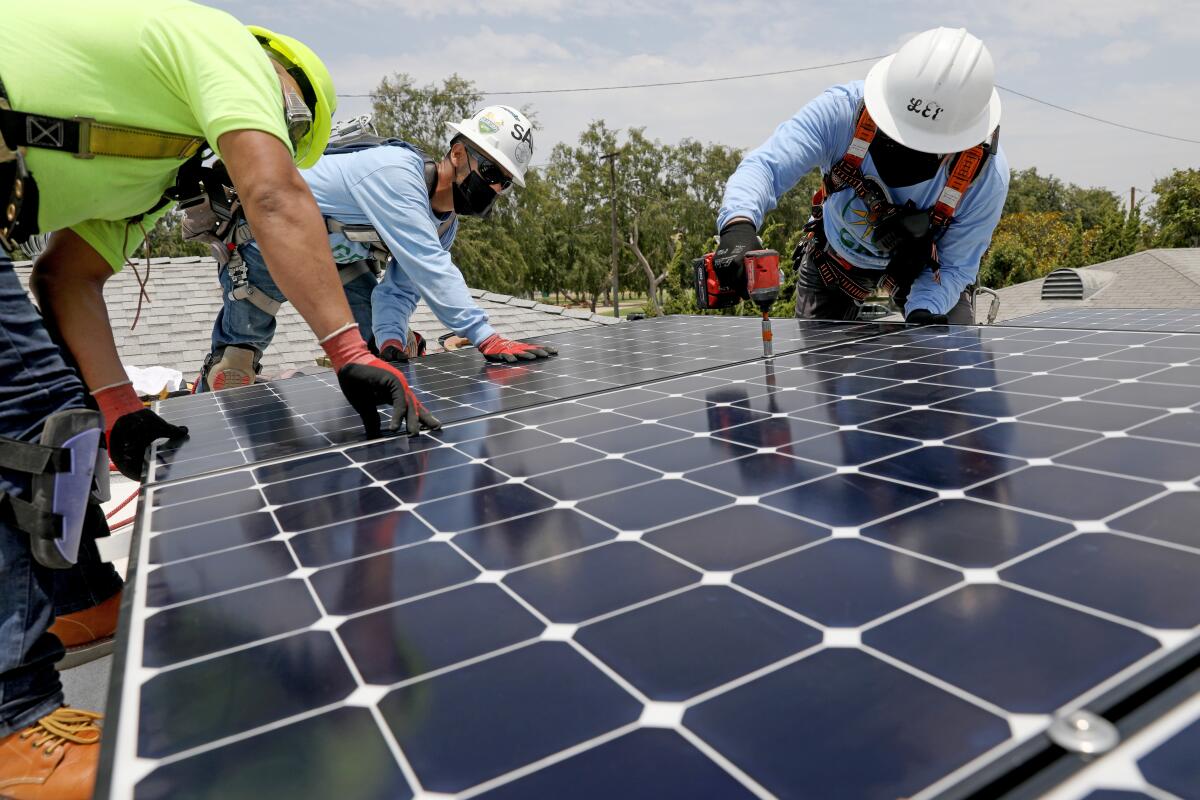Editorial: Don’t slash incentives for California rooftop solar

- Share via
It’s no accident that California is a solar energy leader. One big reason is a state incentive program that has turned about 10,000 rooftop solar installations 25 years ago into more than 1.2 million today.
Small arrays of panels on homes, businesses and other buildings now account for about 11% of the state’s electricity production capacity. Their proliferation is a cornerstone of the state’s efforts to combat climate change, phase out the burning of fossil fuels and get 100% of its electricity from renewable sources by 2045.
So it’s a bit of a head scratcher why Gov. Gavin Newsom’s administration is preparing to make it harder for Californians to go solar.
The state Public Utilities Commission is moving to scale back a key solar incentive program, called net energy metering, with a proposed decision expected as soon as this month. Sweeping changes being sought by utility companies and their allies would make going solar more expensive for regular people and undermine the nation’s largest, most robust rooftop market.
That would be a terrible mistake. Reaching California’s clean-energy goals and confronting climate change will require both large-scale solar farms and continued growth in rooftop solar. Getting more solar panels on homes and businesses, especially in combination with battery storage, will allow quicker retirements of gas-fired power plants that pollute the air and heat the planet. If state regulators change solar incentives too drastically, they risk slowing progress on renewable energy at a time when it needs to be accelerating.
But regulators seem poised to significantly dial back the program, perhaps by shrinking the amount of money power companies are required to credit solar customers for the excess electricity their panels generate and feed into the grid. They blame solar incentives for driving up electricity rates — which are among the nation’s highest — and say those costs are shouldered disproportionately by younger, lower-income households and renters.
It’s reasonable for commissioners to reconsider credits and incentives that drove the market in early days now that solar rooftop systems are more affordable, but they need to tread lightly and avoid undermining one of the nation’s most popular and successful renewable energy programs.
They should not give in to the state’s three biggest power companies, Pacific Gas & Electric, Southern California Edison and San Diego Gas & Electric, whose proposals to reduce credits would roughly triple the time it would take for solar customers to make back their investments in rooftop panels, and would also charge them a fixed monthly fee that would further discourage new installations.
Ultimately, any slowdown in the growth of solar means losing ground in the fight against climate change. The stakes have become all too clear to Californians, who have in just the past few years experienced devastating wildfires, deadly heat waves, historic drought, horrible air quality and other rapidly worsening consequences of the continued burning of fossil fuels.
The battle over rooftop solar in California has become mired in the divisive and at times confusing politics of organized labor and racial and economic justice.
Investor-owned utility giants, with the support of the labor unions whose workers typically build large-scale solar farms, as well as ratepayer watchdogs and powerful Democratic politicians, claim big changes are needed to address fundamental inequities. They say the current subsidies benefit solar customers, who tend to be wealthier and whiter, at the expense of the poorer communities of color by shifting billions in costs — including the maintenance of transmission systems and projects to prevent power lines from igniting wildfires — to other ratepayers, including those who don’t have solar, can’t afford it or rent their homes.
On the other side are solar installation companies, whose workers are typically nonunion, and environmental activists who distrust the monopoly utility companies and want the solar revolution to be decentralized. They dismiss arguments about an unfair shifting of costs and accuse utility giants of trying to restrict the growth of rooftop solar because it’s a threat to their business model.
It’s true that utilities, due to economies of scale, can produce electricity more cheaply by building massive solar farms than by paying customers for their rooftop power generation. But solar farms, often located in sensitive desert habitats, have environmental impacts that rooftop arrays on existing buildings do not. Rooftop systems, which currently cost about $17,000 on average after federal tax credits, remain out of reach for many Californians, even with current subsidies. Increasing the payback time on that investment from about five years to more than 15 years, as utility companies want, would make going solar pencil out for even fewer families and businesses.
Any changes that affect only future adopters, and not existing customers, could also cement the inequity of solar ownership by grandfathering in those who will continue to enjoy decades of low electricity bills regardless of what the commission decides.
Solar panels keep getting less expensive and there are encouraging signs that more low-income people are getting into the market. Only about 12% of solar adopters in California have incomes below $50,000 a year, but that percentage has been moving upward in recent years. This is no time to slam the brakes.
Whatever state regulators decide, California must find a way to target rooftop solar investments in low-income communities of color that are hardest hit by pollution, extreme heat and other climate impacts but have so often been left out of the benefits of clean energy.
Officials should include strong provisions to prioritize disadvantaged communities for solar installations, be it through upfront rebates or more generous credits. California’s transition to carbon-free electricity should not perpetuate inequality, but ensure everyone reaps the fruits of a more sustainable future.
More to Read
A cure for the common opinion
Get thought-provoking perspectives with our weekly newsletter.
You may occasionally receive promotional content from the Los Angeles Times.










